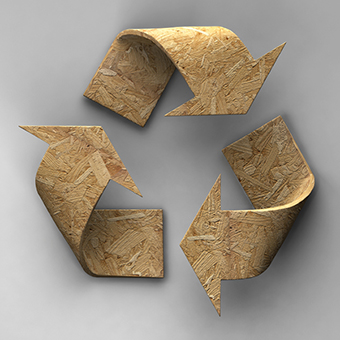Wood waste falls into many categories and must be treated differently depending on its size and previous use. In this article we will examine what to do with four types of wood products found around the home: yard waste, untreated wood, treated/painted wood and home goods such as toys and kitchen accessories.
 The yard is an ever-bearing source of wood that can be put back to good use. Composters prize wood as a good source of carbon-rich (or “brown”) material that will aerate their piles and provide food for the healthy bacteria that break down organic matter.
Many communities now offer curbside yard waste collection services for customers, but regulations for wood waste differ from place to place. Raleigh, NC’s program is very flexible; wood can be placed in bins with handles or in biodegradable yard waste bags, or tied in bundles and left sitting at the curb. In Little Rock, AR, tree limbs no larger than 6 feet long and 6 inches in diameter must be placed beside the bin containing leaves, weeds and twigs.
Some cities have special collection days for wood instead of regular yard waste collection. Houston residents can place branches and stumps beside the curb on odd-numbered months. In Kansas City, MO, brush collections take place for a few weeks in the spring and fall.
Don’t have a curbside collection program? Your town may have a facility that will accept yard waste for composting. In San Diego, one such program is Miramar Greenery, which is run by the city and co-located with the landfill. Eugene, OR, residents have two privately owned options for green waste disposal: Rexius and Lane Forest Products.
The yard is an ever-bearing source of wood that can be put back to good use. Composters prize wood as a good source of carbon-rich (or “brown”) material that will aerate their piles and provide food for the healthy bacteria that break down organic matter.
Many communities now offer curbside yard waste collection services for customers, but regulations for wood waste differ from place to place. Raleigh, NC’s program is very flexible; wood can be placed in bins with handles or in biodegradable yard waste bags, or tied in bundles and left sitting at the curb. In Little Rock, AR, tree limbs no larger than 6 feet long and 6 inches in diameter must be placed beside the bin containing leaves, weeds and twigs.
Some cities have special collection days for wood instead of regular yard waste collection. Houston residents can place branches and stumps beside the curb on odd-numbered months. In Kansas City, MO, brush collections take place for a few weeks in the spring and fall.
Don’t have a curbside collection program? Your town may have a facility that will accept yard waste for composting. In San Diego, one such program is Miramar Greenery, which is run by the city and co-located with the landfill. Eugene, OR, residents have two privately owned options for green waste disposal: Rexius and Lane Forest Products.
How to recycle wood yard waste
 The yard is an ever-bearing source of wood that can be put back to good use. Composters prize wood as a good source of carbon-rich (or “brown”) material that will aerate their piles and provide food for the healthy bacteria that break down organic matter.
Many communities now offer curbside yard waste collection services for customers, but regulations for wood waste differ from place to place. Raleigh, NC’s program is very flexible; wood can be placed in bins with handles or in biodegradable yard waste bags, or tied in bundles and left sitting at the curb. In Little Rock, AR, tree limbs no larger than 6 feet long and 6 inches in diameter must be placed beside the bin containing leaves, weeds and twigs.
Some cities have special collection days for wood instead of regular yard waste collection. Houston residents can place branches and stumps beside the curb on odd-numbered months. In Kansas City, MO, brush collections take place for a few weeks in the spring and fall.
Don’t have a curbside collection program? Your town may have a facility that will accept yard waste for composting. In San Diego, one such program is Miramar Greenery, which is run by the city and co-located with the landfill. Eugene, OR, residents have two privately owned options for green waste disposal: Rexius and Lane Forest Products.
The yard is an ever-bearing source of wood that can be put back to good use. Composters prize wood as a good source of carbon-rich (or “brown”) material that will aerate their piles and provide food for the healthy bacteria that break down organic matter.
Many communities now offer curbside yard waste collection services for customers, but regulations for wood waste differ from place to place. Raleigh, NC’s program is very flexible; wood can be placed in bins with handles or in biodegradable yard waste bags, or tied in bundles and left sitting at the curb. In Little Rock, AR, tree limbs no larger than 6 feet long and 6 inches in diameter must be placed beside the bin containing leaves, weeds and twigs.
Some cities have special collection days for wood instead of regular yard waste collection. Houston residents can place branches and stumps beside the curb on odd-numbered months. In Kansas City, MO, brush collections take place for a few weeks in the spring and fall.
Don’t have a curbside collection program? Your town may have a facility that will accept yard waste for composting. In San Diego, one such program is Miramar Greenery, which is run by the city and co-located with the landfill. Eugene, OR, residents have two privately owned options for green waste disposal: Rexius and Lane Forest Products.